ARCHIVED - Canada's Energy Future - Reference Case and Scenarios to 2030 - Energy Market Assessment - Errata
This page has been archived on the Web
Information identified as archived is provided for reference, research or recordkeeping purposes. It is not subject to the Government of Canada Web Standards and has not been altered or updated since it was archived. Please contact us to request a format other than those available.
30 January 2008
In reference to corrections for the following document:
Canada's Energy Future - Reference Case and Scenarios to 2030 - November 2007
1. French version of report, page xxi, Figure AA.10, Perspectives de production de gaz naturel canadien, replace with the following:
Figure AA.10
Perspectives de production de gaz naturel canadien
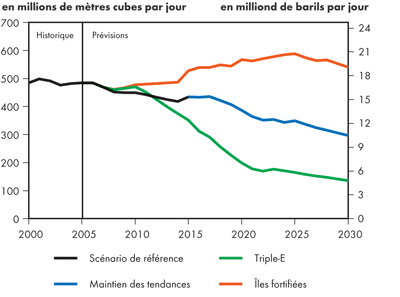
2. Analytical Overview, page xx, Figure AO.11, Canadian Natural Gas Exports, replace with the following:
Figure AO.11
Canadian Natural Gas Net Exports
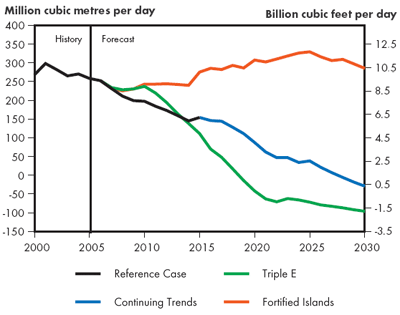
3. a. Analytical Overview, page xxiv, Table AO.1, replace text to read: GHG Emissions, Triple E scenario, -0.1%.
b. Analytical Overview, page xxiv, Greenhouse Gas Emissions, replace text to read:
Consideration of these and others as part of a full spectrum of GHG reduction strategies could go a long way in contributing to Canada meeting its target of 20 percent by 2020.
4. French version of the report, Chapter 2, page 7, Natural Gas, replace text to read:
C'est en Russie, en Iran et au Qatar que se trouvent presque 60 % des réserves mondiales de gaz naturel.
5. Chapter 3, page 14, Energy Prices, Crude Oil Prices, replace text to read:
Although Canada is ranked as one of the largest oil producers in the world, Canada produces less than three percent of total daily world production and is therefore a price-taker.
6. Chapter 3, page 23, Figure 3.12, Eastern Canada Light Crude Production - Reference Case, replace with the following:
Figure 3.12
Eastern Canada Light Crude Production - Reference Case
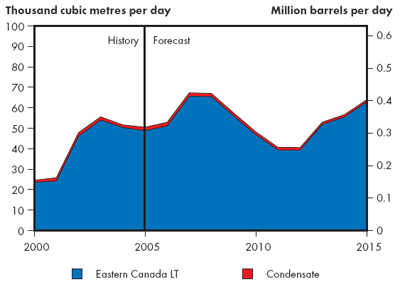
7. Chapter 3, page 25, Oil Sands Supply, replace text to read:
Total purchased natural gas requirements, excluding on-site electricity requirements, increase from 18.4 million m³/d (0.65 Bcf/d) in 2005 to 51.0 million m³/d (1.8 Bcf/d) by 2015.
8. Chapter 4, page 45, Figure 4.13, Eastern Canada Light Crude Production - Continuing Trends, replace with the following:
Figure 4.13
Eastern Canada Light Crude Production - Continuing Trends

9. Chapter 4, page 47, Oil Sands Supply, replace text to read:
Total purchased natural gas requirements, excluding on-site electricity requirements, reach 53.8 million m³/d (1.9 Bcf/d) by 2030.
10. Chapter 4, page 49, Figure 4.18, Supply and Demand Balance, Natural Gas - Continuing Trends, replace with the following:
Figure 4.18
Supply and Demand Balance, Natural Gas - Continuing Trends
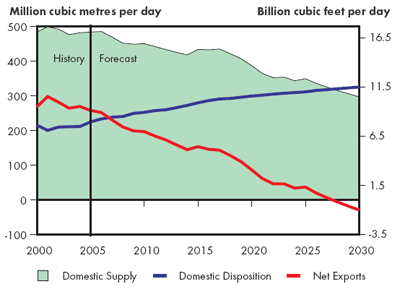
11. Chapter 4, page 56, Continuing Trends Issues and Implications, replace text to read:
The key risks and uncertainties surrounding the Continuing Trends Scenario include
12. French version of report, Chapter 5, page 71, Figure 5.4, Demande canadienne totale d'énergie secondaire selon le combustible - Triple-E, replace with the following:
Figure 5.4
Demande canadienne totale d'énergie secondaire selon le combustible - Triple-E
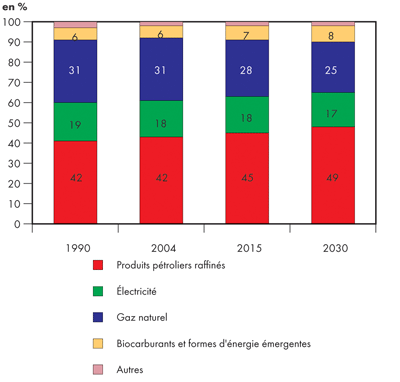
13. Chapter 5, page 75, Figure 5.14, Eastern Canada Crude Production - Triple E, replace with the following:
Figure 5.14
Eastern Canada Crude Production - Triple E

14. Chapter 5, page 75, Oil Sands Supply, replace text to read:
Total purchased natural gas requirements, excluding on-site electricity requirements, increase slightly from 0.65 Bcf/d in 2005 to 0.9 Bcf/d by 2030, in line with muted oil sands production growth.
15. Chapter 5, page 79, Figure 5.19, Supply and Demand Balance, Natural Gas - Triple E, replace with the following:
Figure 5.19
Supply and Demand Balance, Natural Gas - Triple E
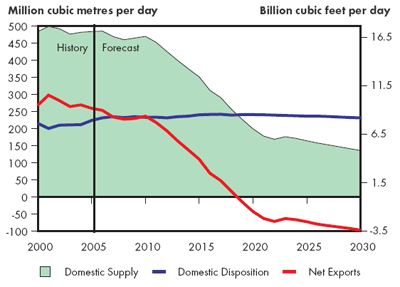
16. Chapter 5, page 84, Figure 5.24, Canadian Total GHG Emissions by Sector - Triple E, replace with the following:
Figure 5.24
Canadian Total GHG Emissions by Sector – Triple E
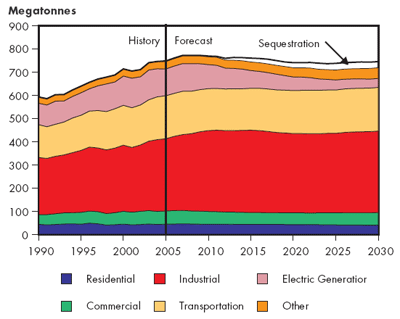
17. Chapter 6, page 96, Oil Sands Supply, replace text to read:
In this scenario, the purchased natural gas intensity is reduced from 0.67 Mcf/b in 2005 to 0.49 Mcf/b in 2030, with total purchased natural gas requirements, excluding on-site electricity requirements, increasing from 18.4 million m³/d (0.65 Bcf/d) in 2005 to 62.3 million m³/d (2.2 Bcf/d) by 2030, in line with substantial oil sands production growth.
18. Appendix 1, Key Drivers, Table A1.1, Economic Indicators, Canada (revised)
19. Appendix 3, Oil and Natural Gas Liquids, new Tables A3.13, A3.14, A3.15 (additional tables)
20. Appendix 4, Natural Gas, new Tables A4.2, A4.3, A4.4 (additional tables)
The Board apologizes for any inconvenience caused by these changes.
- Date modified:
